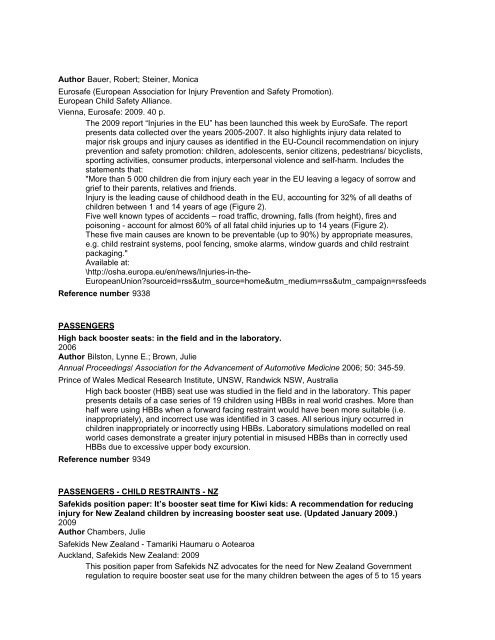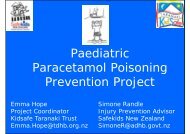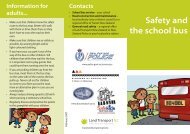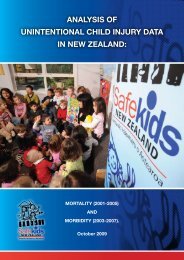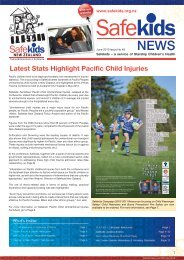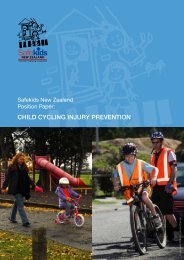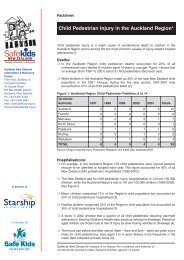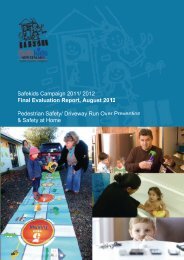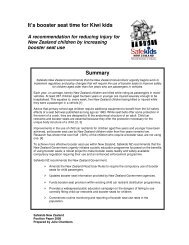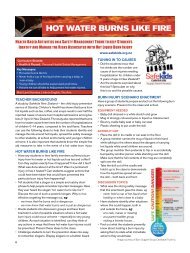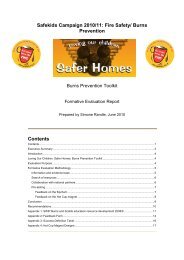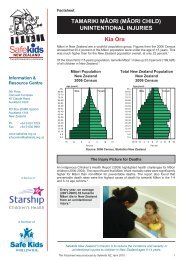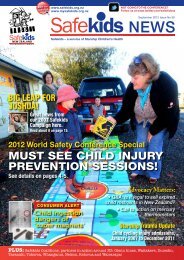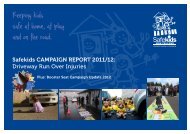Safekids Information Centre KidsInfo Bulletin March-April 2010
Safekids Information Centre KidsInfo Bulletin March-April 2010
Safekids Information Centre KidsInfo Bulletin March-April 2010
Create successful ePaper yourself
Turn your PDF publications into a flip-book with our unique Google optimized e-Paper software.
Author Bauer, Robert; Steiner, Monica<br />
Eurosafe (European Association for Injury Prevention and Safety Promotion).<br />
European Child Safety Alliance.<br />
Vienna, Eurosafe: 2009. 40 p.<br />
The 2009 report “Injuries in the EU” has been launched this week by EuroSafe. The report<br />
presents data collected over the years 2005-2007. It also highlights injury data related to<br />
major risk groups and injury causes as identified in the EU-Council recommendation on injury<br />
prevention and safety promotion: children, adolescents, senior citizens, pedestrians/ bicyclists,<br />
sporting activities, consumer products, interpersonal violence and self-harm. Includes the<br />
statements that:<br />
"More than 5 000 children die from injury each year in the EU leaving a legacy of sorrow and<br />
grief to their parents, relatives and friends.<br />
Injury is the leading cause of childhood death in the EU, accounting for 32% of all deaths of<br />
children between 1 and 14 years of age (Figure 2).<br />
Five well known types of accidents – road traffic, drowning, falls (from height), fires and<br />
poisoning - account for almost 60% of all fatal child injuries up to 14 years (Figure 2).<br />
These five main causes are known to be preventable (up to 90%) by appropriate measures,<br />
e.g. child restraint systems, pool fencing, smoke alarms, window guards and child restraint<br />
packaging."<br />
Available at:<br />
\http://osha.europa.eu/en/news/Injuries-in-the-<br />
EuropeanUnion?sourceid=rss&utm_source=home&utm_medium=rss&utm_campaign=rssfeeds<br />
Reference number 9338<br />
PASSENGERS<br />
High back booster seats: in the field and in the laboratory.<br />
2006<br />
Author Bilston, Lynne E.; Brown, Julie<br />
Annual Proceedings/ Association for the Advancement of Automotive Medicine 2006; 50: 345-59.<br />
Prince of Wales Medical Research Institute, UNSW, Randwick NSW, Australia<br />
High back booster (HBB) seat use was studied in the field and in the laboratory. This paper<br />
presents details of a case series of 19 children using HBBs in real world crashes. More than<br />
half were using HBBs when a forward facing restraint would have been more suitable (i.e.<br />
inappropriately), and incorrect use was identified in 3 cases. All serious injury occurred in<br />
children inappropriately or incorrectly using HBBs. Laboratory simulations modelled on real<br />
world cases demonstrate a greater injury potential in misused HBBs than in correctly used<br />
HBBs due to excessive upper body excursion.<br />
Reference number 9349<br />
PASSENGERS - CHILD RESTRAINTS - NZ<br />
<strong>Safekids</strong> position paper: It’s booster seat time for Kiwi kids: A recommendation for reducing<br />
injury for New Zealand children by increasing booster seat use. (Updated January 2009.)<br />
2009<br />
Author Chambers, Julie<br />
<strong>Safekids</strong> New Zealand - Tamariki Haumaru o Aotearoa<br />
Auckland, <strong>Safekids</strong> New Zealand: 2009<br />
This position paper from <strong>Safekids</strong> NZ advocates for the need for New Zealand Government<br />
regulation to require booster seat use for the many children between the ages of 5 to 15 years


